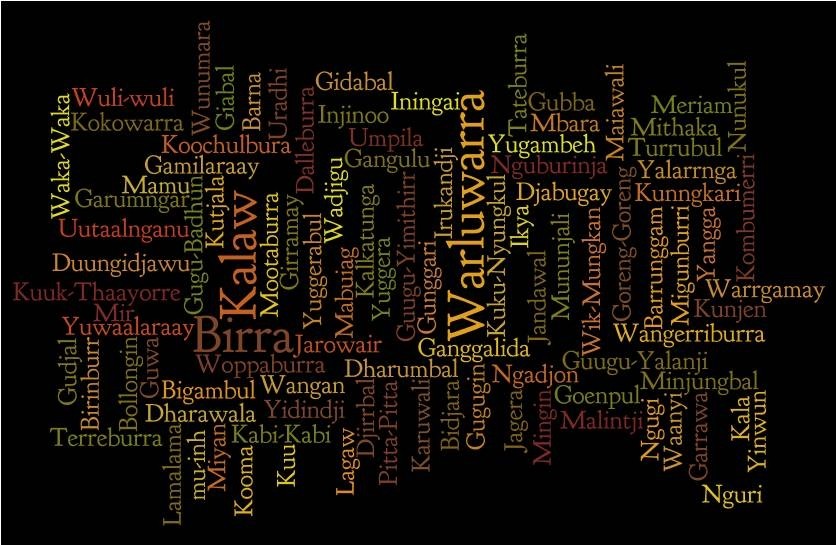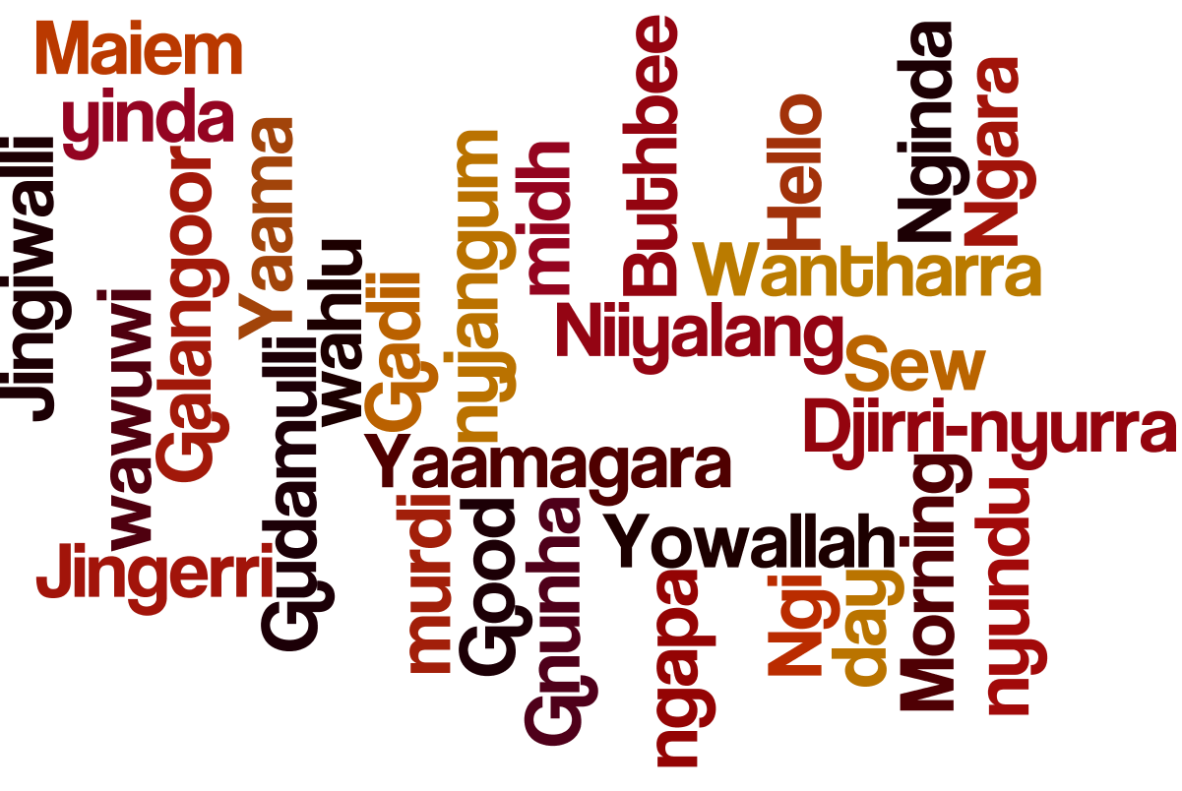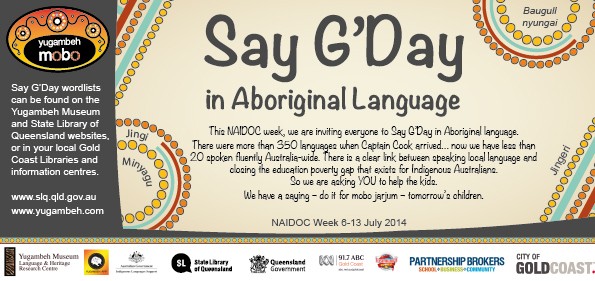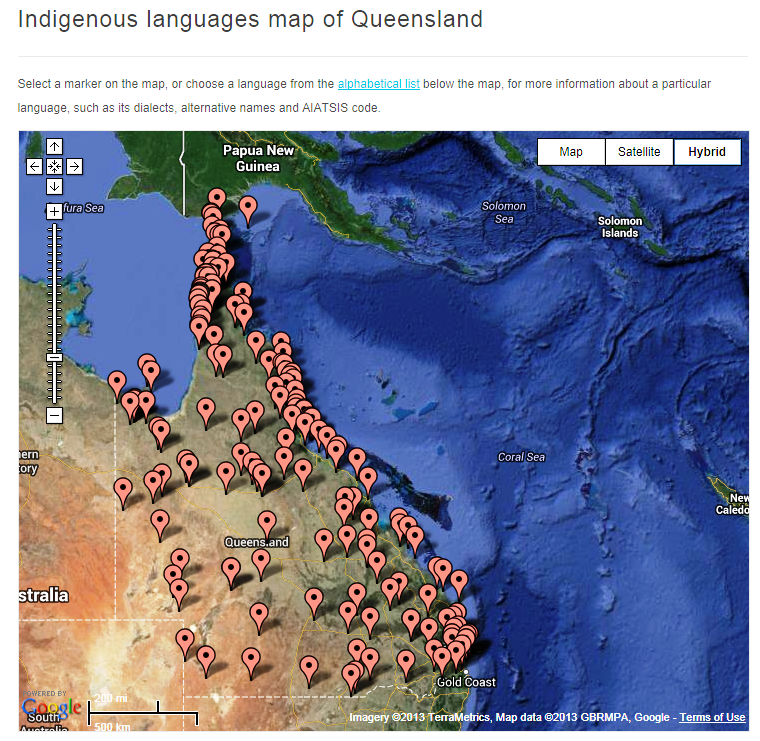Many Australians can say 'bonjour' or 'konnichiwa' for hello in French or Japanese, but how many people know how to say g'day' in an Aboriginal or Torres Strait Islander language?
How many people know the name of their local Aboriginal or Torres Strait Islander language?
Do you know any words from your local Indigenous language?
Are there place-names, landmarks or even house names that reflect the traditional language of your area?
Did you know that in Queensland there are over 100 Aboriginal and Torres Strait Islander languages and dialects?

Over 100 Queensland Indigenous languages/dialects!
Today only about 30 are spoken on a daily basis! Of these only 3 are classed as strong or thriving languages; the remaining languages are classed as endangered! State Library has an Indigenous Languages Strategy which aims to document, preserve and promote the rich diversity of Aboriginal and Torres Strait Islander languages across Queensland. Activities such as language workshops, online resources and digitisation support community groups, language centres and language workers in community language revival. We are continually looking for new ways to promote Aboriginal and Torres Strait Islander languages in the wider Queensland community.

Say G'day wordle in Queensland Indigenous languages.
The State Library of Queensland in partnership with Yugambeh Museum, Language and Heritage Research Centre, Indigenous Language Centres and other community groups are excited about this new initiative for NAIDOC Week 2014.
“Say G’day in an Indigenous Language!”
During NAIDOC week, State Library would like to encourage Queenslanders to be part of the week! We ask you to find out about your local Indigenous language and discover the local word for 'g'day' and use it during NAIDOC Week. This action is a simple, yet effective way to raise awareness of Queensland's Aboriginal and Torres Strait Islander languages.

Flyer for the "Say G'day" initiative.
A good starting point to identifying your local community language is the State Library's Indigenous Languages Map of Queensland. This interactive map allows users to explore regions and towns across Queensland and identify the traditional Aboriginal or Torres Strait Islander languages from that area. Hyperlinks will take the reader to items within the State Library collections that relate to that particular language.


The State Library and Yugambeh Museum will have some wordlists on their websites to get you started and don't forget to follow the conversation on Twitter - we will be using the following hashtags: #saygday #indigenouslanguages #naidocweek.
Have a great week with the “Say G’day” Campaign and don’t forget to share your stories with others, including State Library. Hopefully this initiative will raise awareness of Indigenous languages in your community and support the ongoing revival and maintenance of Aboriginal and Torres Strait Islander languages in Queensland.
Note: there is an updated blog post on State Library's Aboriginal and Torres Strait Islander Languages Blog featuring over 100 language greetings!
Desmond Crump
Indigenous Languages Coordinator, kuril dhagun
State Library of Queensland Aboriginal and Torres Strait Islander Languages webpages
State Library of Queensland Aboriginal and Torres Strait Islander Languages blog
References and Further Readings:
The following items in State Library collections can help you find out more about your local Aboriginal or Torres Strait islander language; perhaps even the word for "G'day"!
Aird, M. (1996) I know a few words: Talking about Aboriginal Languages. Keeaira Publications: Southport. G 499.15 1996
Allan, J. and Lane, J. (2001) The language of the Wangerriburra and neighbouring groups in the Yugambeh region. Kombumerri Aboriginal Corporation for Culture: Beenleigh. P 499.15 all
Ash, A., Giacon, J. and Lissarrague, A. (2003) Gamilaraay, Yuwaalaraay, Yuwaalayaay Dictionary. IAD Press: Alice Springs. J 499.1503 GAM
Barlow, H. (1865) Harriet Barlow Manuscript. Provides the basis for her work “Aboriginal Vocabularies of Queensland”. OM91-69.
Bell, J. (1994) Dictionary of the Gubbi-Gubbi and Butchulla languages, compiled with the assistance of Amanda Seed. Jeannie Bell: Brisbane. G 499.15321 1994
Bell, J. (2004) Dictionary of the Butchulla language. Korrawinga Aboriginal Corporation: Hervey Bay. G 499.15 2004
Blake, B. and Breen, J. G. (2007) An illustrated dictionary of Yulluna by domains. Yulluna Land Council and James Cook University: Mount Isa. J 499.51 ILL
Breen, J.G. (1981) The Mayi Languages of the Queensland Gulf Country. Canberra: Australian Institute of Aboriginal Studies Press. J 499.15 bre
Breen, J.G. (1990) Salvage Studies of Western Queensland Aboriginal Languages. Australia Pacific Linguistics, Canberra. J 499.15 bre
Dixon, R. M. W. (1972) The Dyirbal language of north Queensland. London: Cambridge University Press. G 499.15 1972
Dixon, R. M. W. (1991) Words of our country: stories, place names and vocabulary in Yidiny, the Aboriginal language of the Cairns-Yarrabah region. St Lucia, Qld: University of Queensland Press. G 499.15 1991
Edwards, R. (Ed) (2001) Dictionary of Torres Strait languages. Rams Skull Press: Sydney. Q 499.1503 RAY
Helon, G. (1994) The English-Goreng Goreng-English dictionary. Gurang Land Council: Bundaberg. G 499.15 1994
Holmer, N. (1983) Linguistic Survey of South-Eastern Queensland. Australian National University: Canberra. J 499.15 HOL
Mathew, J. (1910) Two representative tribes of Queensland: with an inquiry concerning the origin of the Australian race. T Fisher Unwin: London. J 306.0899915 MAT
Patz, E. (2002) A grammar of the Kuku Yalanji language of north Queensland. Canberra: Pacific Linguistics. J 499.15 PAT
Sharpe, M. (1998) Dictionary of Yugambeh, including neighbouring dialects, compiled by Margaret Sharpe from various sources: Pacific Linguistics C-139. Canberra: Pacific Linguistics. G 499.15 1998
Terrill, A. (2002) Dharumbal: the language of Rockhampton, Australia. Pacific Linguistics 525. Canberra: Pacific Linguistics. J 499.15 TER
Watson, F. J. (1944) “Vocabularies of four representative tribes of South Eastern Queensland”; supplement to the Journal of the Royal Geographical Society of Australasia (Queensland), No. 34, Vol XLVIII. REFJ 499.15 wat
Websites:
Australian Institute of Aboriginal and Torres Strait Islander Studies (AIATSIS): www.aiatsis.gov.au
Our Languages: www.ourlanguages.net.au
State Library of Queensland Indigenous Languages webpages: www.slq.qld.gov.au/resources/atsi/languages
Yugambeh Museum website: www.yugambeh.com
Listen to Indigenous Languages at State Library:
Re-told: A re-telling of stories and songs from Myths and legends of the Torres Strait.
Ngampa Kugu ngampara Thayan Piamu (Keeping Language Strong). A digital story on a Language Research Discovery Workshop held at State Library in March 2012.
Comments
Your email address will not be published.
We welcome relevant, respectful comments.